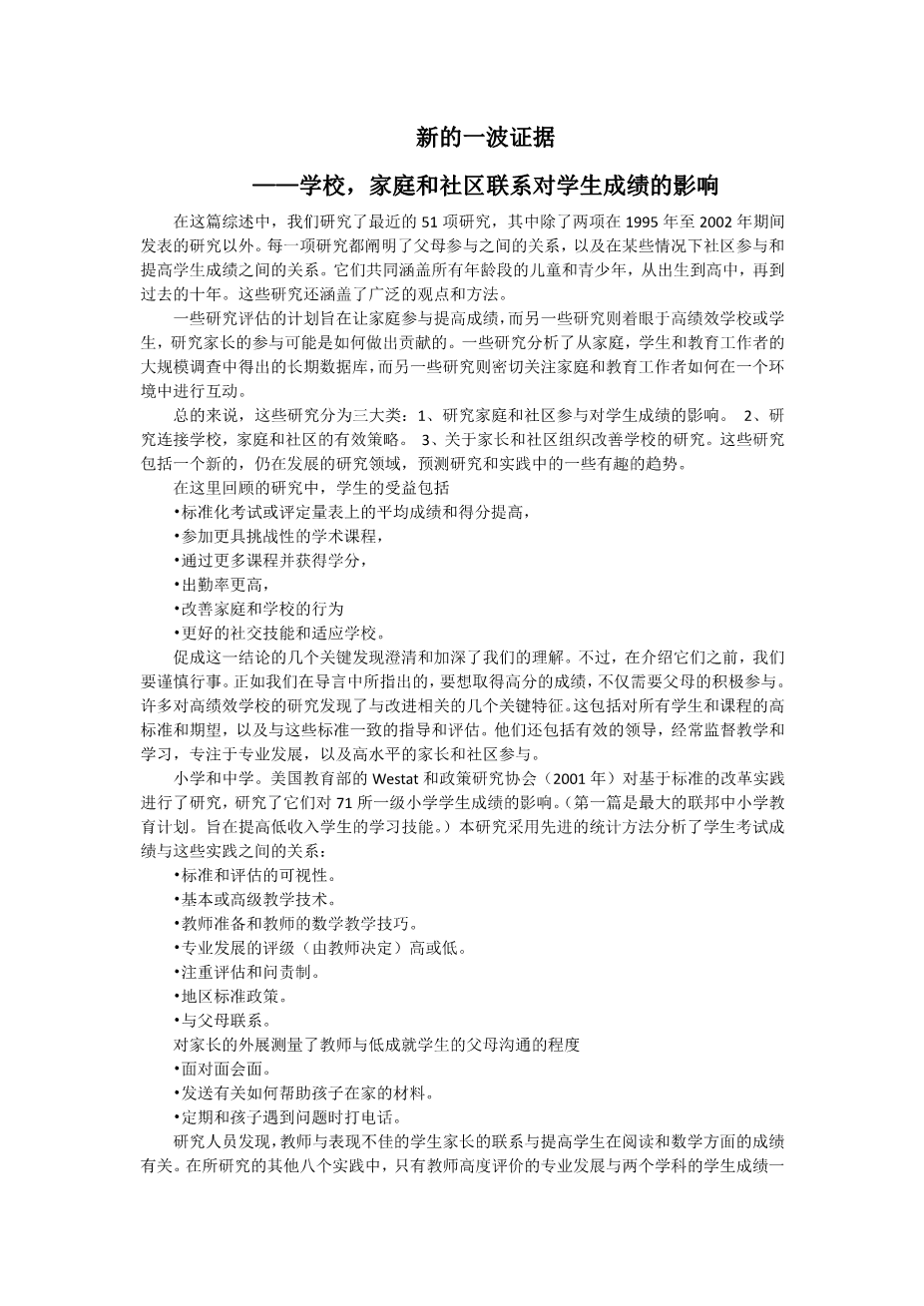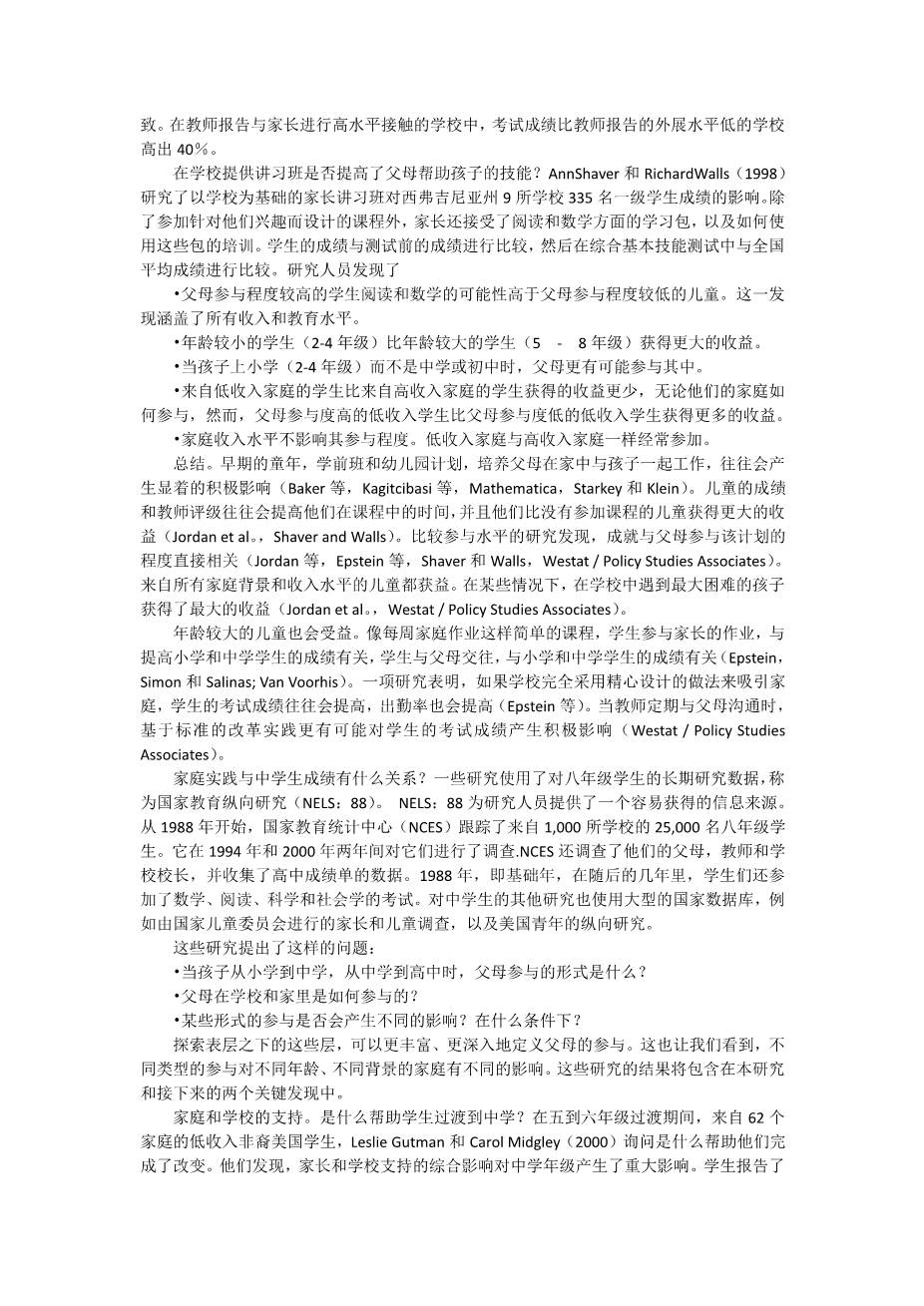A New Wave of Evidence
——The Impact of School, Family, and CommunityConnections on Student Achievement
In this review, we look at 51 recent studies, all but two published from 1995 to 2002. Every one sheds some light on the relationship between parent involvement and, in some cases, community involvement and improved student achievement. Together they cover children and youth of all ages, from birth through high school and into the postsecondary years. These studies also cover a wide range of perspectives and approaches.
Some studies evaluate programs that are designed to engage families in improving achievement, while others look at high-performing schools or students to study how parent involvement may have contributed. Several studies analyze long-term databases drawn from large-scale surveys of families, students, and educators, while others focus closely on how families and educators interact in a single setting.
In general, the studies fall into three broad categories: 1. Studies on the impact of family and community involvement on student achievement. 2. Studies on effective strategies to connect schools,families,and community. 3. Studies on parent and community organizing efforts to improve schools.These studies comprise a new, still developing arena of research that forecasts some interesting trends in both research and practice.
Among the studies reviewed here, the benefits for students include
bull; higher grade point averages and scores on standardized tests or rating scales,
bull; enrollment in more challenging academic programs,
bull; more classes passed and credits earned,
bull; better attendance,
bull; improved behavior at home and at school, and
bull; better social skills and adaptation to school.
Contributing to this conclusion are several key findings that clarify and deepen our understanding. Before presenting them, however, we would like to sound a caution. As we point out in the introduction, it takes more than engaged parents to produce high student achievement. Many studies of high-performing schools identify several key characteristics associated with improvement. These include high standards and expectations for all students and curriculum, as well as instruction and assessments aligned with those standards. They also include effective leadership, frequent monitoring of teaching and learning, focused professional development, and high levels of parent and community involvement.
Elementary and middle school.A study of standards-based reform practices done by Westat and Policy Studies Associates (2001) for the U.S. Department of Education looked at their impact on student achievement in 71 Title I elementary schools. (Title I is the largest federal program for elementary and secondary education. It is aimed at improving the academic skills of low-income students.) The study used an advanced statistical method to analyze the relationship between student test scores and these practices:
bull; Visibility of standards and assessments.
bull; Basic or advanced teaching techniques.
bull; Teacher preparation and teachersrsquo; skills in math instruction.
bull; High or low ratings (by teachers) of professional development.
bull; Focus on assessment and accountability.
bull; District standards policies.
bull; Outreach to parents.
Outreach to parents measured how much teachers communicated with parents of low-achieving students through
bull; meeting face to face.
bull; sending materials on ways to help their child at home.
bull; telephoning both routinely and when their child was having problems.
The researchers found that teacher outreach to parents of low-performing students was related to improved student achievement in both reading and math. Of the eight other practices studied, only professional development that was highly rated by teachers was as consistently linked to student gains in both subjects. In schools where teachers reported high levels of outreach to parents, test scores grew at a rate 40 percent higher than in schools where teachers reported low levels of outreach.
Does offering workshops at school enhance parentsrsquo; skills to help their children? Ann Shaver and Richard Walls (1998) looked at the impact of school-based parent workshops on the achievement of 335 Title I students in nine schools in a West Virginia district. In addition to attending sessions designed to their interests, parents received learning packets in reading and math, as well as training in how to use them. The studentsrsquo; gains were compared with pretest scores, then measured against average national gains, on the Comprehensive Test of Basic Skills.
The researchers found that
bull; students with more highly involved parents were more likely to gain in both reading and math than children with less involved parents. This finding held across all income and education levels. bull; younger students (grades 2–4) made greater gains than older students (grades 5–8).
bull; parents were more likely to be involved when their children were in elementary school (grades 2–4) than in middle or junior high school.
bull; students from lower-income families made fewer gains than students from higherincome families, no matter how involved their families. However, low-income students with more involved parents made greater gains than low-income students with less involved parents.
bull; a familyrsquo;s income level did not affect its level of involvement. Low-income families were as likely to attend regularly as higher-income families.
Summing up.Early childhood, preschool, and kindergarten programs that train parents to work with their children at home tend to have significant, positive effects (Baker et al., Kagitcibasi et al., Mathematica, Starkey and Klein). Childrenrsquo;s grades and ratings from teachers tend to improve the longer th
全文共34197字,剩余内容已隐藏,支付完成后下载完整资料


英语译文共 8 页,剩余内容已隐藏,支付完成后下载完整资料
资料编号:[453462],资料为PDF文档或Word文档,PDF文档可免费转换为Word


